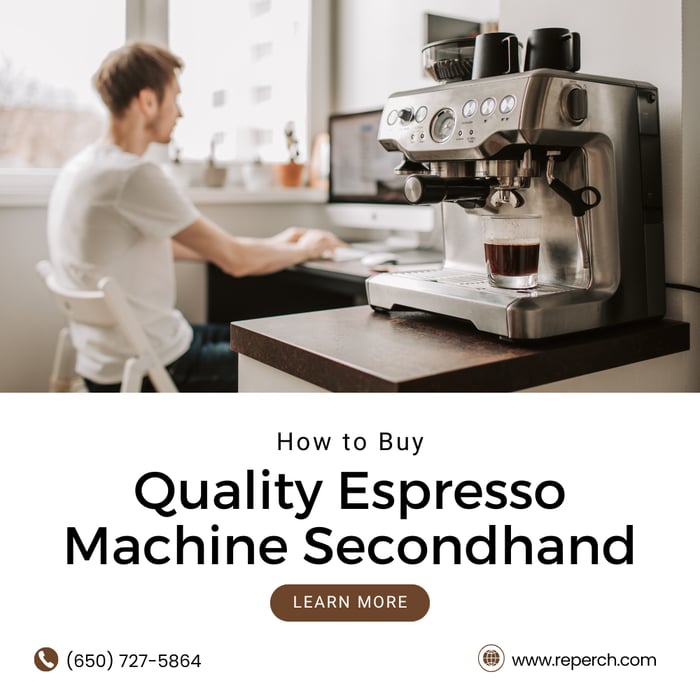Buying a secondhand espresso machine can be a smart move. You get premium equipment at a fraction of the cost, often from people who bought during a trend but never really used it. But it’s not as simple as clicking “buy now.” Quality espresso machines are complex. Their value lies in the internal components, condition, and care history. In this guide, we’ll walk you through everything you need to know to shop smart and make a solid investment.
Why Buy a Used Espresso Machine?
Let’s start with the why. Premium espresso machines like those from Bezzera, Rocket, La Marzocco, and ECM can cost thousands of dollars new. But their build quality means they last for years, sometimes decades, with proper care. When someone decides to upgrade, move, or simply stop using theirs, they often sell it at a deep discount. This creates an opportunity for savvy buyers if you know what to look for.
Step 1: Check the Water History
Water is both the lifeblood and biggest enemy of any espresso machine. Over time, hard water creates limescale buildup inside boilers, pipes, and valves. If not managed properly, this scale can corrode internal parts and lead to costly repairs.
Ask the seller:
What kind of water was used? Ideally, it should be filtered and softened. Tap water with high mineral content can lead to problems.
Was a water softener cartridge used? For machines like Bezzera, this is a must. These cartridges need to be replaced regularly.
Has the machine been descaled? If so, how often and by what method? Descaling too aggressively or infrequently can both cause issues.
Tip: Avoid machines that used distilled or reverse osmosis water without remineralization. These can be corrosive and leach metals like lead from brass components.
Step 2: Watch for Electrical Red Flags
Espresso machines heat water rapidly and require steady electrical flow. If the seller’s home had unstable wiring, it could have caused internal damage.
Ask the seller:
Has the machine ever tripped the circuit breaker?
Does it turn on and heat without any electrical issues?
Have any electronic components like the mainboard or heating element been replaced?
Why it matters: Fixing a damaged heating element or control board can cost hundreds of dollars, sometimes up to 30 percent of the machine’s value.
Step 3: Understand Pressure Performance
Good espresso comes from pressure. Most prosumer machines should generate around 9 bars of brew pressure. A secondhand machine must demonstrate it can still achieve that.
How to test:
If the machine has a pressure gauge, ask the seller to run a test using a blind filter basket, which is a filter with no holes.
Watch the pressure. A steady reading near 9 bars is ideal.
If it’s fluctuating or struggling to reach pressure, it may have a failing pump or scale buildup.
Pump types:
Vibration pumps are standard in many home machines and last about 5 to 7 years.
Rotary pumps are more durable and used in commercial-grade equipment but are expensive to replace.
Step 4: Look for Leaks and Damage
It’s normal for older machines to have a little wear. But leaks, corrosion, or worn-out seals can mean costly repairs.
Ask the seller:
Does the machine leak water or steam?
Are there any known issues with the steam wand or grouphead?
Has it ever had a boiler leak or corrosion damage?
Visual inspection tips:
Check for white mineral buildup around the boiler or internal pipes.
Look for rust spots or pitting, which could indicate corrosive water use.
Test all knobs, wands, and switches to ensure they’re fully functional.
Step 5: Confirm Functionality
Before you buy, make sure the machine does what it’s supposed to do.
Ask for a demo or video showing:
The machine powering on and heating to temperature
Steam wand working properly
Pump activating and holding pressure
No constant dripping or gas venting from the boiler
A shot being pulled from the grouphead
This helps confirm that the machine’s core systems such as heating, pressure, and water flow are in good shape.
Step 6: Ask About Usage History
How the machine was used and how often tells you a lot about its condition.
Ask questions like:
How often was the machine used?
Was it used in a home or commercial setting?
How long has the seller owned it?
Was it moved frequently or kept in one place?
A well-loved machine that lived in one home and was cleaned regularly is more reliable than one that’s been passed around and rarely maintained.
Step 7: Understand the Real Cost
Used espresso machines may be cheaper upfront, but they might come with hidden costs.
Budget for:
Minor repairs such as seals, gaskets, and o-rings
Routine maintenance like descaling and cleaning kits
Potential major fixes such as pump replacement or electrical issues
Accessories such as grinder, tamper, milk pitcher, and water softener
Average repair costs:
Vibration pump replacement: $140 to $210
Rotary pump replacement: $500 or more
Touchscreen if applicable: Up to $500
Grouphead or boiler repairs: Variable, often 10 to 40 percent of machine value
Step 8: Get Proof of Purchase
Ask the seller for their original purchase receipt if available. This helps confirm:
The model and generation
Whether it’s under any transferable warranty
That the machine isn’t stolen
Some brands do not allow warranty transfers. Others do, but only under specific terms. Knowing the model and serial number helps if you ever need service.
Step 9: Know Where to Buy
There’s no official resale channel for espresso machines, but these are the most common options:
Facebook Marketplace
Craigslist
eBay
Local coffee forums
Secondhand appliance shops
Specialty used equipment dealers
Tip: Avoid sellers who refuse to answer questions or won’t let you inspect the machine in person or at least via video.
Step 10: Be Patient and Do Your Homework
You don’t need to rush. Inventory changes constantly, and great deals pop up regularly.
Smart buyer checklist:
Compare similar models across listings
Keep a running list of questions
Ask for videos when buying remotely
Research average resale values
Factor in shipping or transport costs
The right machine at the right price is worth the wait. Don’t settle for a fixer-upper unless you’re prepared for the work and cost involved.
Final Thoughts
Buying a secondhand espresso machine is one of the best ways to get barista-level gear for your home at a fraction of the price. But it’s only a deal if the machine is in good condition. Take your time, ask the right questions, and look for machines that have been loved, not neglected.
At Reperch, we believe in smart, sustainable shopping. Buying quality secondhand furniture and appliances saves money and reduces waste. Whether you’re outfitting your living room or building a home coffee bar, our guides are here to help you make informed, confident decisions.








